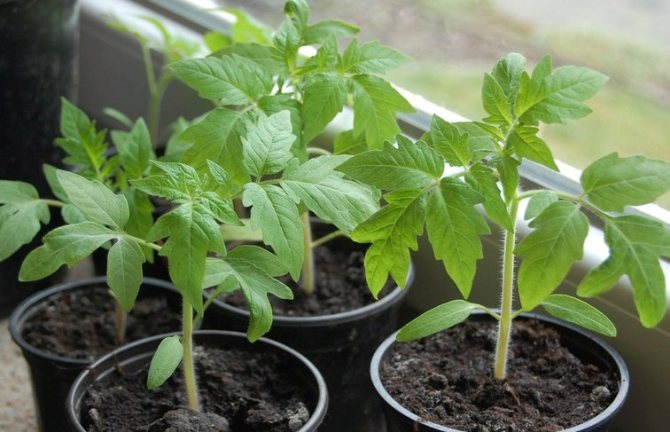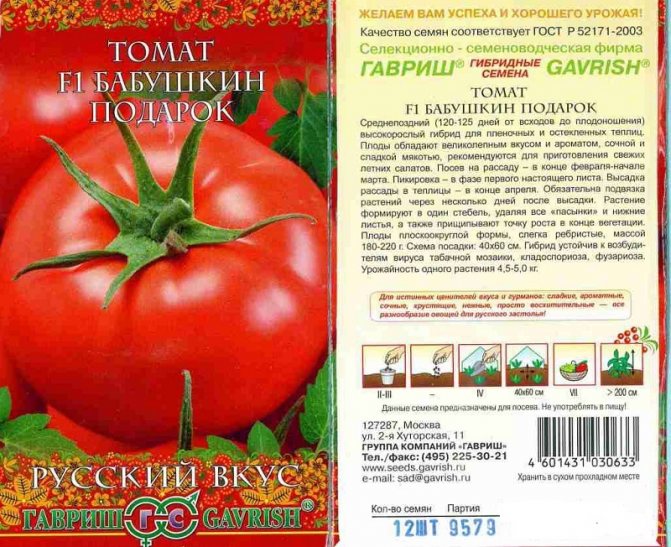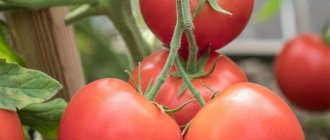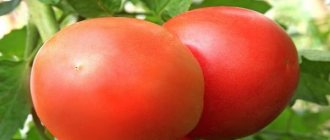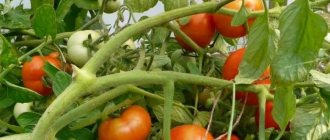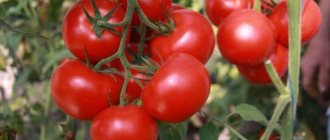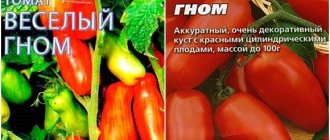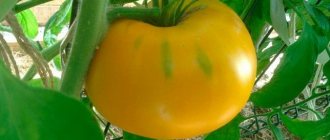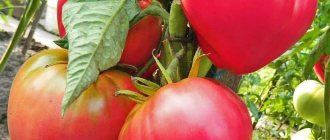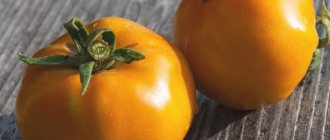Babushkino is a tomato variety that pleases with abundant fruiting and is not capricious in terms of care. It is not a hybrid, but it has its own distinctive characteristics and unique taste. This variety tolerates Russian cold and drought normally. It can be grown in an open bed under a film or in a greenhouse. It has strong immunity to diseases.
The harvest of the Babushkino tomato variety directly depends on regular high-quality care, the nuances of cultivation and the fertility of the land. All this is important to know. Those who planted these tomatoes never regretted it, as they always got a lot of delicious fruits as a result for fresh food or preservation.
Description of the Babushkino variety
Tomato Babushkino belongs to large-fruited species. It is suitable for growing in greenhouses and outdoors. Ripening period is medium early. From the moment of emergence to the harvest of the first tomatoes, an average of 120 days pass. Bushes are tall, indeterminate, can grow more than 2 meters in height, so it is recommended to grow them on a trellis. The leaves are of a classic shape, medium in size.
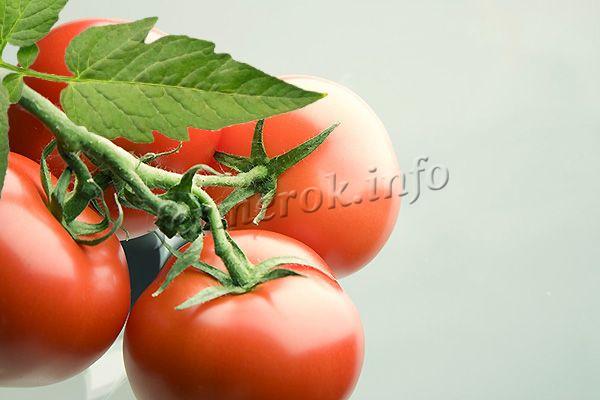
Up to 4 fruits are formed on each hand
Up to 4 fruits are formed on each cluster. With proper care, fruits can reach a mass of 1000 g, but more often gardeners grow tomatoes at 220-380 g. The shape is round-flat, the ribs are weakly expressed. After full ripening, the tomato acquires a beautiful, red-pink color, the stalk does not have a green spot, but a yellow spot may appear. The skin is dense, but thin, edible. The pulp is moderately firm, with a high content of juice, pink in color. There are not many seeds. The taste is pleasant, it harmoniously combines sweetness and sourness.
Important!
With proper care, timely feeding, Babushkino's tomato can grow up to 1 kg! Such record holders, of course, need to be tied up so that they do not break off the branch on which they grow.
Characteristics of the variety
Description of the Babushkino variety should start with the fact that this tomato is not a hybrid, and it does not have F1 hybrid forms that can grow without pollinators. Therefore, tomato bushes will need to be pollinated: with the help of insects or by hand (when tomatoes grow in a closed greenhouse).
Since the Babushkino variety is not included in the State Register, it is quite difficult to find the seeds of this tomato on sale. Usually, the planting material of such tomatoes is sold by amateur breeders, and not by large seed companies.
A detailed description of the Babushkino tomato variety:
- the plant belongs to the indeterminate type, that is, it does not have an end point of growth;
- bushes are not considered standard, their crown must be formed in the process of development;
- the ripening time of tomatoes is medium early - for full ripeness, a tomato needs from 3.5 to 4 months from the day of sowing the seeds;
- the height of the bushes often exceeds 220 cm, so they must be tied up;
- tomatoes can be grown both outdoors and in a greenhouse - it depends on the region and climate;
- the Babushkino tomato is considered very resistant to external factors: the plants tolerate a drop in temperature well, feel normal in the heat, rarely get sick;
- fruits are formed in clusters, in each of which up to 12 tomatoes can be tied;
- the shape of the tomatoes is flat-round, there may be a slight ribbing;
- the color of a ripe tomato is raspberry red, the pulp is a rich red hue;
- there are several chambers inside the tomato, there are very few seeds;
- the pulp of a tomato is fleshy, very juicy, sweet with a slight sourness;
- the taste of the variety is excellent, the tomato is suitable for any purpose;
- the mass of fruits is quite large - from 300 to 800 grams;
- the productivity of the bush is high, but only with sufficient nutrition;
- there are a lot of dry substances in the fruits, so they are stored well and for a long time.
You can use Babushkino's tomatoes for absolutely any purpose. Mashed potatoes and juices are prepared from the fruits, fresh salads are made, tomatoes are salted and pickled as a whole or cut. This variety is also great for sale, because tomatoes are stored for a long time and tolerate transportation well, have a very presentable appearance.
Description of fruits
Considering Babushkino's tomato variety description, the characteristics of its fruits can be limited to several points:
- their number in each brush;
- color;
- the weight of the tomatoes;
- taste;
- use.
With the growth of the bush, the first brushes are formed at the level of 8 leaves.
Clusters are loose and bear about 12 flowers. Usually gardeners recommend leaving no more than 8 brushes on the bushes. But you need to look at the condition of the plant and leave as much as a certain bush can feed them, without reducing the yield.
The flowers open almost simultaneously. After pollination, fruits are tied, which must be immediately fixed on the supports. As they grow and mature, they cannot, under their own weight, harm the parent bush and break it.
At the stage of milky ripeness, the fruits are colored light green, with a characteristic dark spot at the stalk. Ripening, tomatoes turn red, but some may carry a lighter shade, at the same stalk.
The tomatoes themselves of our Babushkino variety are distinguished by the fact that they have almost no seeds in the ovaries of the first wave. They are fleshy and contain up to 4 seed chambers, but no seeds.
To collect your own seeds, you need to wait for the second wave of flowering. These fruits will contain seeds, but also in small quantities. They should be enough for their own needs.
The taste of the fruit is usually tomato and sweet, if the soil does not dry out when growing tomatoes. If there is little moisture, then sourness may appear in the tomatoes. With a long stay on the bushes, overripe tomatoes are prone to cracking. Therefore, they need to be collected on time.
Characteristics of Babushkino tomato
Check out these articles as well
- Tomato variety Grandee
- Blizzard cabbage variety
- How to keep dill fresh for the winter
- The best varieties of eggplant for greenhouses
Gardeners note many positive characteristics of the Babushkino variety.
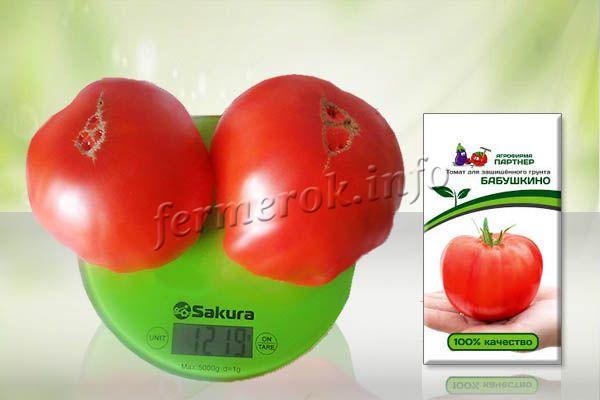

With proper care, timely feeding, Babushkino's tomato can grow up to 1 kg!
- Pest attacks, with timely treatment, are not reflected on the plant.
- There is a stable immunity to viruses, fungal ailments.
- The yield is high. From a bush, you can collect 5 kg of fruits per season, from a square meter - 22 kg of tomatoes.
- Plants are resistant to climate change, sudden drops or rises in temperature.
- The fruits are large, fragrant.
- The taste is excellent.
- The fruits do not show themselves well in transportation, even over short distances.
In general, according to the quality of the fruits, their taste, we can say that Babushkino's tomato deserves a place on the site. It makes very tasty lecho, juice, pasta and other similar dishes.
Important!
The tomato variety Babushkino has practically no sourness in taste, for which it is appreciated by many gardeners.
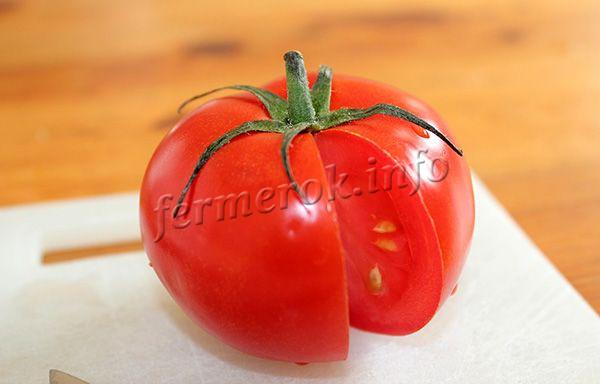

The pulp is moderately firm, with a lot of juice
Summary
The Babushkino tomato variety definitely deserves the attention of both beginners and experienced gardeners. The main advantage of tomato is its stability and fertility.All the disadvantages of the variety are associated with insufficient soil nutrition, therefore, the gardener should pay particular attention to fertilizing.
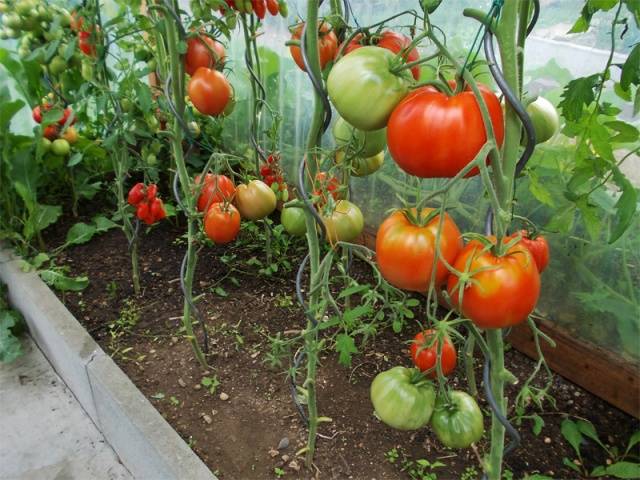

To collect your own planting material, you need to leave on the bushes several large and beautiful fruits from the last ovary. The reviews of those who have already planted this tomato are mostly positive, especially farmers note the excellent taste of Babushkino's tomato and the size of its fruits.
Disadvantages of the Babushkino variety
The main disadvantage of this variety is that it is difficult to find quality seeds. Since it is not registered, fakes are often sold under its guise - this is important to consider. Most gardeners rely on conscientious collectors to love and grow this variety year after year.
- Fruits can be severely cracked. The larger the fruit, the larger and deeper the cracks. At the same time, of course, the marketability of tomatoes decreases.
- Despite the commercial qualities, the fruits are difficult to sell, because when they reach the market, they become very soft and lose all their attractiveness.
- Not suitable for whole canning.
- Plants are demanding to feed.
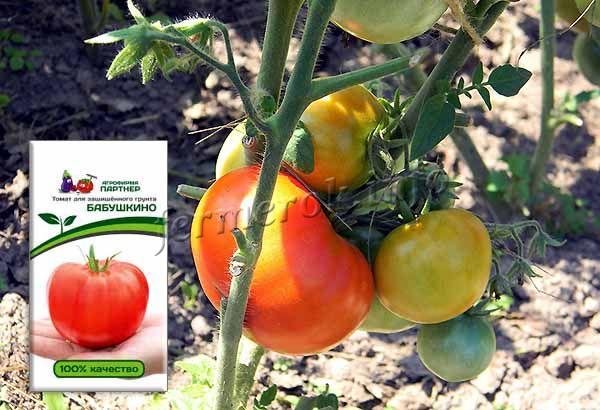

Tomato seeds Babushkino must be purchased from lovers of the variety, breeders, since they are almost never sold in stores
Important!
Tomato seeds Babushkino must be purchased from lovers of the variety, breeders, since they are almost never sold in stores.
It should also be taken into account that the variety is not listed in the State Register. No exact specifications have been recorded. Many gardeners are disappointed in Babushkino's tomatoes in the very first year of cultivation, as they do not meet the expectations and overestimation of the variety lovers.
Advantages and disadvantages
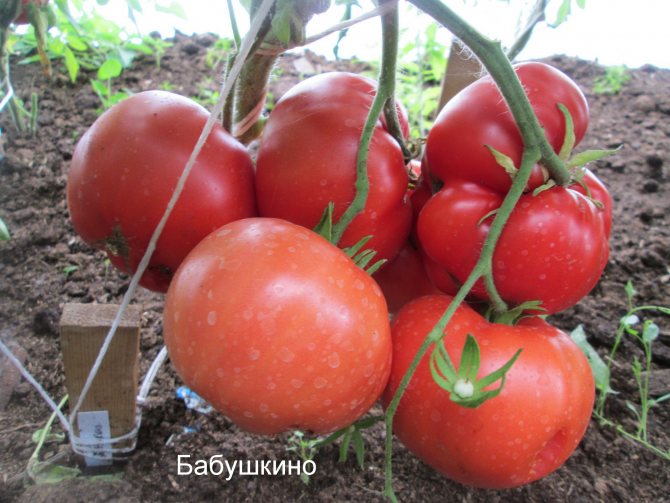

Each tomato has its own merits. By purchasing seeds from dealers or collectors, you can buy excellent material, or you can become the owner of a misgraded one.
"Babushkino" has a number of advantages:
- excellent taste of fresh fruit;
- good yield, subject to high agricultural technology;
- large-fruited;
- disease resistance;
- versatility of use;
- excellent quality tomato products.
Seedlings of tomatoes Babushkino
We recommend reading our other articles
- Open field cucumber varieties
- Description and characteristics of the Yaroslavl breed of cows
- Raspberry transplant in autumn
- How to get rid of ants
The easiest way to grow Babushkino's tomatoes is through seedlings. The seeds are sown in early March to be planted in mid-May in a permanent place. If the planting of seedlings in the ground will be carried out later, then the seeds are sown at the end of March.
In advance, the seeds are soaked in water for 2-3 days (the water must be constantly changed). Containers for growing seedlings must be filled with earth and compacted. It is advisable to pour with a weak solution of potassium permanganate in order to disinfect.
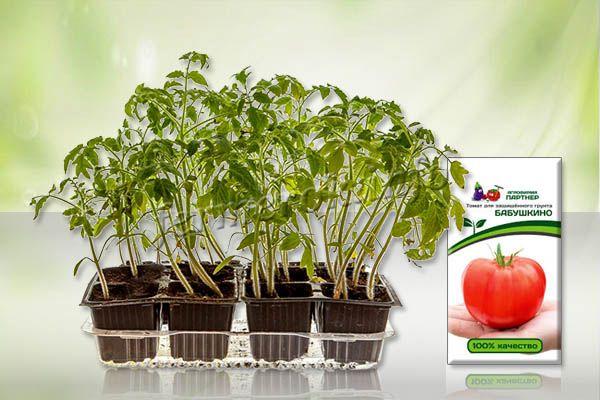

The easiest way to grow Babushkino's tomatoes is through seedlings
The seeds that have hatched are laid out directly on the surface of the soil and sprinkled with a thin layer of earth. Seeds are placed at a distance of 2-3 cm from each other. After sowing, you need to water the ground with water (it is better to spray with a spray bottle) and cover with a plastic bag or glass. They should germinate at a temperature of +26 degrees.
When the seeds hatch, you need to remove the film, lower the temperature to +15 degrees for 1 week so that they do not stretch. After a week, you can raise the temperature again to +21 degrees. It is at this temperature that tomato seedlings should be grown until hardening.
Seedling care is not time consuming. It is necessary to water it on time, if desired, fertilize it with complex fertilizer, when 2 leaves appear. It also does not hurt to dive the sprouts into separate cups. So they will develop better. But many gardeners do without picking.
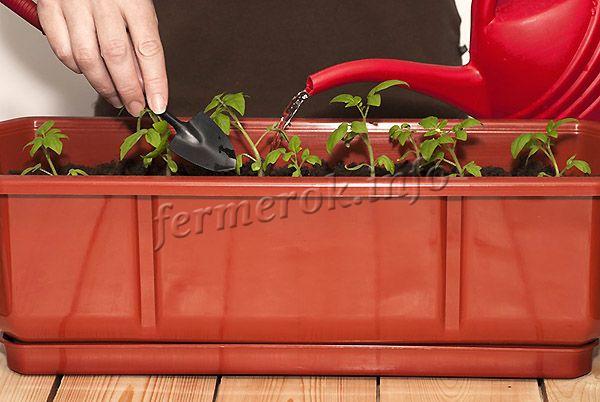

It is necessary to water the seedlings on time, if desired, fertilize with complex fertilizer
If a pick is carried out, then you need to choose good cups (preferably peat or paper), fill 1/3 with soil. Then the tomatoes are taken out of the old container, gently undermining with a knife, and then transferred to a new glass and covered with soil. You can deepen the seedling up to the cotyledon leaves. After planting, the ground is watered and identified in a bright place.
Interesting!
If, when picking the sprouts into separate cups, tear off the lower part of the root by 1/3, the root system will develop better.
Features of growing and care
Like most varieties, Babushkino tomatoes are grown in seedlings. Sowing is carried out 1.5-2 months before transplanting into the garden (the sowing date varies depending on the climate). The seeds are sown in warm soil. The soil should be selected loose and fertile. Until germination, containers with crops are kept under a film in a warm room. While the seedlings are growing, watering is done with warm water very carefully so as not to break the soil. Feeding is carried out twice with complex fertilizer.
When the plants form two true leaves, the seedlings must dive. This stimulates the root system and prepares the tomatoes for the upcoming transplant. For 7-10 days, the plants need to be hardened on the balcony. Start at 1 hour, gradually increasing the time.
When the seedlings have 6-8 leaves, they can be transplanted into the garden. The earth is carefully dug up and flavored with fertilizers. Holes are made in advance, at the rate of 3-4 pieces per 1 sq. m. The first 2 weeks do not touch the plants, then you can feed the bushes and start watering as needed. Watering is carried out with warm water under the root. It is worth remembering that excess moisture can lead to cracking of the fruit.
The bush is formed into 2-3 stems, removing unnecessary stepsons and leaves. The stem is tied to a solid support, and supports are placed under the brushes with tomatoes so that they do not break under their own weight.
Plants are very sensitive to the composition of the soil, so they are regularly fed with both mineral and organic fertilizers. The bushes huddle, the soil is loosened and freed from weeds.
Features of planting tomatoes
Tomato variety Babushkino can grow in different types of soil, but it must be fertilized, with normal acidity. Ideally, the site should be sheltered from the winds, sunny. Landing is carried out when the threat of return frosts passes.
Important!
Tomatoes cannot be planted after nightshades, otherwise diseases and pests will be difficult to avoid.
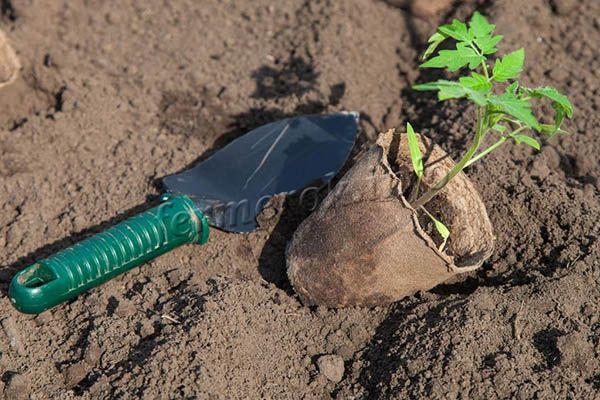

If the seedlings grew in peat cups, then you can plant the sprouts with them.
Planting is carried out in pits located at a distance of 40-50 cm. The row spacing is done with a distance of 50-70 cm. The seedlings ready for transplanting are taken out of the pots and planted in the pits. If it grew in peat cups, then you can plant sprouts with them. During planting, it is not strongly recommended to deepen the shoots, but it is even a little useful for the development of the root system.
Reviews who planted
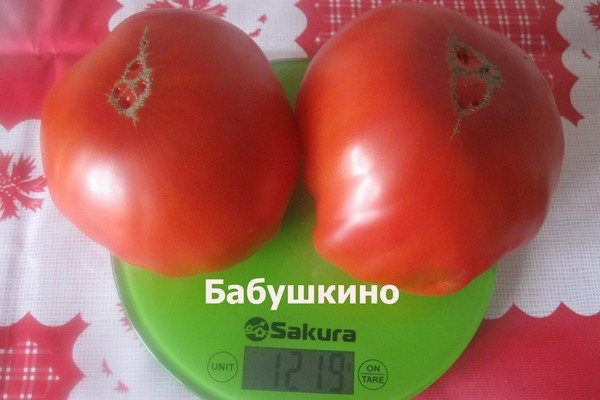

Marisha, Saint Petersburg
This variety Babushkino led in a greenhouse in two shoots, grew up to 220 cm, the tomatoes are large, round, bright red and very fleshy, the taste is sweet, and the weight is about 400 grams, there were 5 tomatoes in the brush. The yield is high, and the keeping quality is good, so I will definitely plant it next year.
Veronica, Moscow
The variety is quite fruitful, the tomatoes are large and even at the top, but the shoulders became a disadvantage, although there were not many sunny days. Another variety grew nearby, but it did not have shoulders, and the care was the same. Perhaps I did something wrong. On another occasion, I will take into account that the variety is especially sensitive to a lack of potassium-magnesium.
kalinka-malinka, Saint Petersburg
They grew up in my greenhouse. At the beginning of summer, large clusters with large tomatoes appeared, which were very tasty. But then gaps began, and others formed a little smaller, but large ones were again tied under the very ceiling.Most likely, the weather was good for fruit growth and formation.
Nadine, Volgograd
My tomato mass reached 400 grams, there weren't too large ones, on the first bunches they were smaller, and higher ones were already larger. I liked it very much for its brightness, almost shiny tomatoes, everything is even, the taste is traditionally tomato, with sweetness, and fruitful. She formed 3 shoots.
Rules for caring for a tomato Babushkino
Many gardeners consider the variety to be unpretentious, but everyone has a certain opinion. In general, you cannot do without care, but there are no serious difficulties in growing it.
- Timely watering is essential for any tomato variety. This one is no exception. Watering is carried out not frequent, but plentiful.
- The earth should not be crusty. If this happens, it is loosened with a glanders or similar garden tool.
- Weed cleaning is necessary so that the plants are less sick and get the maximum benefit from fertilizing, watering, and loosening the soil.
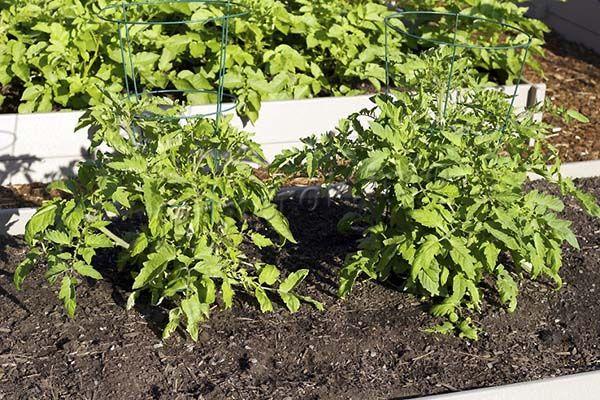

Babushkino's tomato is grown on a trellis or high support
- Tomato Babushkino is grown on a trellis or a high support, as the variety is indeterminate. As the bushes grow, you need to make sure that they cling to the support, without bending to the side. If necessary, the bush is tied up.
- If large fruits ripen on the branches, it is advisable to tie them to a support so that the tomatoes do not fall when ripe.
- The plant must be properly shaped in order for it to produce a sufficient yield. Bushes form in 2 and 3 stems.
- The plant reacts sharply to a lack of nutrients, so top dressing must be applied in a timely manner. Fertilizers are applied organic and mineral. In this case, you need to alternate them.
Important!
Babushkino's tomato needs regular feeding. This issue needs special attention!
Growing rules
Photos of ripe fruits and bushes, simply "covered" with large tomatoes, are pushing many gardeners to buy seeds of the Babushkino variety. But in order to grow this tomato, you need to know some features.
Planting tomatoes
Like all tomatoes, Babushkino is grown in Russia through seedlings. Therefore, the first thing a gardener will have to do is to find the seeds of this tomato on sale. Of course, you can try to find ready-made seedlings, but this is difficult, since the variety is quite rare.
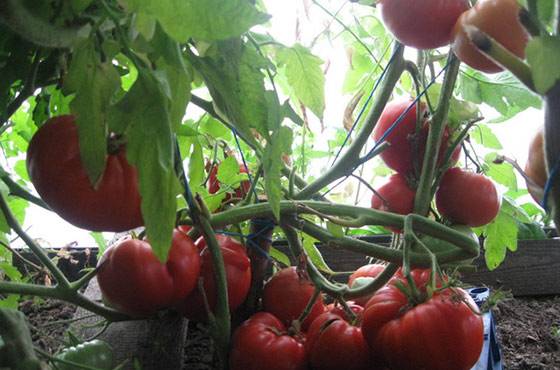

The gardener should act in the following sequence:
- Decide on the timing of sowing seeds for seedlings. Like all tomatoes, the Babushkino variety is sown 1.5-2 months from the expected date of planting in a permanent place. The seedlings of this tomato are transferred to the greenhouse in early to mid-May, but the tomato can be planted in the beds by the end of May - early June. Based on this, it is recommended to sow seeds in late March or early April.
- The seeds are sown in warm soil. The soil is chosen loose, well fertilized, capable of retaining moisture. Until the tomatoes germinate, they are under the film in a warm place.
- You need to water the seedlings with warm water, this will accelerate its development and protect against diseases.
- Two or three times you will need to feed the tomatoes with mineral fertilizers - the Babushkino variety is very fond of feeding.
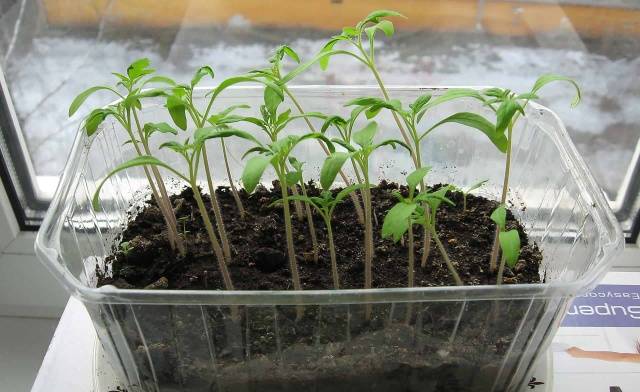

- The seedlings must be dived when two leaves each grow. This stimulates the root system to grow and prepares the seedlings for planting in the ground.
- Before taking the tomato to the greenhouse or to the garden bed, they must be hardened. This is done carefully and gradually, every day, lowering the temperature and increasing the time of the procedure.
- When the outside temperature allows, and when the seedlings have 6-8 true leaves, they can be transferred to a permanent place.
- The holes are made in advance, after fertilizing and digging up the ground on the site. The distance between the holes should be large, because the bushes of Babushkino's tomato are powerful and tall. An interval of 50-60 cm between tomatoes is recommended.
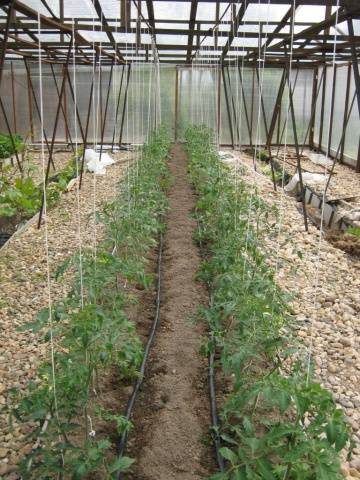

The first couple of weeks the tomatoes are not touched, at this time they must adapt to new conditions.When the seedlings get stronger, new leaves begin to appear, you can feed the plants and start actively watering them.
Tomato care
Reviews about the Babushkino tomato variety are contradictory, but those gardeners who paid much attention to exactly caring for their plantings were satisfied with this tomato. Like all indeterminate varieties, Babushkino needs regular and competent care.
In the process of developing a tomato, he will need the following:
- Bush formation. It is customary to leave only two or three stems, removing the rest of the stepchildren, which will only lead to an increase in green mass and shrinking of fruits.
- A tall bush will definitely have to be tied up using pegs, trellis or other supports. Powerful clusters with several large tomatoes often break branches, so each ripening bunch also needs to be strengthened.


- Tomato Babushkino is very sensitive to the composition of the soil - this tomato needs abundant nutrition. Therefore, you need to feed the tomato often and in large quantities. Both organic and mineral fertilizers are suitable.
- If the "shoulders" begin to turn yellow in the fruits, potassium and magnesium are added to the soil. After that, the ripening of the tomatoes should become more even.
- The bushes huddle, the earth is periodically loosened, weeds are pulled out. You can use mulch to hold in moisture.
- Watering Babushkino's tomato is best with warm water. Watering is especially important at the stage of fruit pouring, but excess water will lead to cracking, so the gardener must be careful.
- Diseases practically do not affect this variety, pests also rarely appear on the bushes. For prevention purposes, it is still better to process the bushes during the flowering period.
- You need to harvest in a mature or slightly unripe form. Fruiting in a tomato Babushkino is stretched - a month and a half the plants will delight with fresh fruits.
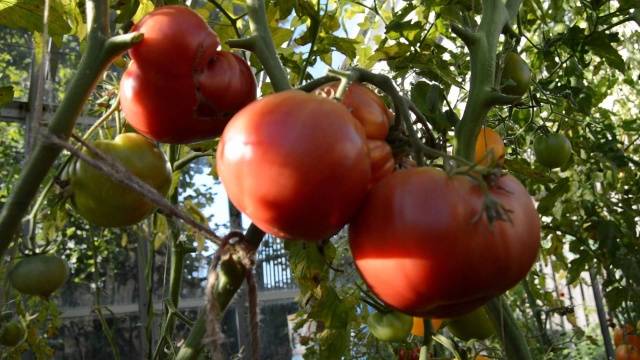

Diseases and pests of the variety
The variety is resistant to diseases, according to many gardeners. It should be borne in mind that there is not a single variety or hybrid of tomatoes that are resistant to all diseases. So sooner or later some problems will arise anyway.
It is possible to prevent the development of the disease through preventive treatments. To do this, you can use specialized fungicides or some folk remedies. The first treatment is carried out about a week after the plant is transplanted to a permanent place. It is important that the bush has time to take root. As the tomato grows, you can also process the planting 1-2 times to prevent the development of diseases.
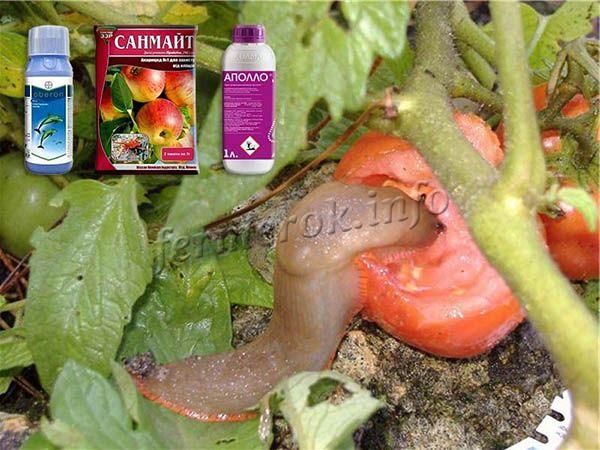

Slugs, spider mites, whiteflies, wireworms, aphids can settle on Babushkino's tomato
If a disease nevertheless appears on the bushes, they are treated with specialized agents - fungicides. The best are Skor, Ridomil Gold, Revus, Quadris. Medical treatments are done strictly according to the instructions.
More problems arise not with diseases, but with pests. Slugs, spider mites, whiteflies, wireworms, aphids can settle on Babushkino's tomato. A bear can also do a lot of harm. To combat them, you can use insecticides ("Goodwin", "Mospilan"), acaricides ("Sunmight", "Apollo", "Oberon"). You can also destroy them with folk remedies: infusion of mustard, hot pepper, garlic, dandelion, set traps and baits. These pests also do not like spraying with a solution of vinegar or whey.
Pest and disease control
Tomato variety Babushkino is resistant to many diseases. But insects may well attack him.
Insecticidal preparations will help from them, but the treatment is carried out before the fruits begin to set. Later, it is better to deal with pests using folk methods.
The most common insects that damage tomatoes are:
- Slugs. They feed on the leaves and fruits of tomatoes. Rot subsequently appears on the plant. A mixture of ash, lime and tobacco dust will help with slugs. It will also be effective to sprinkle the soil loosened after watering with hot pepper.
- Spider mite. A small insect that sucks juice from tomato leaves, entangling them with cobwebs. Parts of the plant turn yellow and then die off. Traditional methods of struggle include spraying with a solution of garlic and dandelion.
- Medvedka. Large insect, brown in color. Makes moves in the top layer of the soil and gnaws at the roots of plants. Get rid of the bear with the help of infusion of bitter pepper or vinegar.
- Wireworm. This is the larva of the click beetle. Damages the root system of tomatoes, sometimes it can penetrate the stem.
Liming of acidic soils is a preventive measure. Experienced gardeners, before planting seedlings, make a bait from carrots, beets or potatoes, lay it in the ground, and then simply collect the pest.
- Whitefly. Has two pairs of prominent white wings. Causes mottled yellowing of the leaf. In the place where the insect leaves its secretions, sooty fungi appear. The plant turns black and dies. Soap solution or infusion of garlic will save you from whitefly.
Harvesting and processing of the tomato Babushkino
The ripening of the first tomatoes can be observed from the beginning of June, with timely planting in the greenhouse. If Babushkino's tomato grows in the open field, then the first fruits are harvested about 2-3 weeks later. The duration of fruiting is about 2 months, but the main stage is 2-4 weeks. It is at this time that most of the fruits are harvested. Tomatoes are harvested immediately after ripening, otherwise they may crack and start to rot.
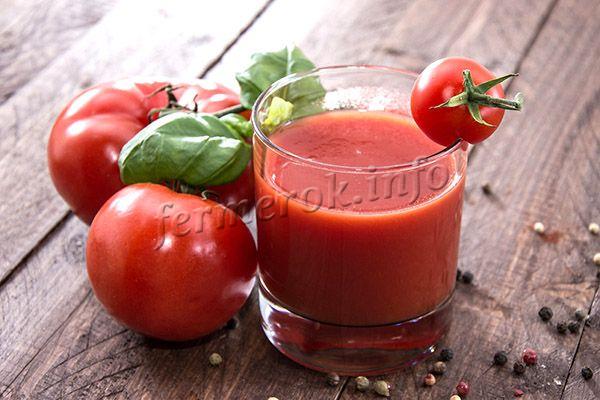

It is best to make tomato juice from this variety.
Babushkino's tomato is used mainly for preparing salads, summer snacks, that is, fresh. From preservation, it is best to make tomato juice, mashed potatoes, borsch dressing, lecho, pasta and similar dishes from this variety. But for canning in a whole form, the fruits are not suitable because of their size. In addition, the thin skin cracks quickly in jars.
Care
In order for the culture to develop correctly, it is necessary to engage in the formation of a bush, leaving only 2-3 lateral shoots at the main stem, the rest must be cut off.
Due to the height of the plant, trellises, high stakes or other support are used so that it does not break under the weight of large fruits.
A rich soil is important, so apply fertilizers based on potassium and magnesium 2-3 times per season, you can use organic (aqueous solution of humus - 1: 8 or chicken droppings - 1:10, herbal infusion) or mineral (Agricola, Good Strength "," Kid ").
():
Long before planting seedlings (from autumn), the soil under the tomatoes is dug up with the introduction of humus or compost (8-10 kg per 1 sq. M.), As well as mineral fertilizers: superphosphate - 40-50 g per 1 sq. M. meter and potassium salt - 50-60 g per 1 sq. meter.
Water the crop early in the morning or late in the evening. The variety does not really like excess moisture: because of it, fungal diseases develop.
Reviews of gardeners about the Babushkino tomato variety
The opinions and reviews of gardeners about the Babushkino tomato variety differ.
- Mila Grishina: “I have been growing Babushkino's tomato for the third year in a row. I bought seeds from a friend who grows them. I always plant in a greenhouse, near a trellis, so that they give an early harvest. If you carefully consider the care, temperature and humidity in the greenhouse, they will not have time to crack before harvesting. The taste is pleasant, the skin is thin. I only use it for fresh salads! "
- Sava Polyakov: “I like Babushkino's tomato with its taste, so the fruits are very large, and with a pleasant, tomato aroma. Unlike hybrids, they have a natural taste with sweetness, pleasant flesh. But, unfortunately, there are few seeds, and it is not easy to find them in the store. And there are a lot of cracked fruits, they are poorly stored. Because of this, I will not plant any more ”.
- Antonina Medvedeva: “I plant a tomato of the Babushkino variety every year for food. The whole family loves him. Of course, the harvest is not stored for a long time, and it is problematic to transport it from the dacha, but it is worth the effort.Vitamin salads are obtained from it, juice with a natural, pleasant taste. I don’t buy seeds, but collect them from grown tomatoes. They do not germinate well, so it is better to leave at least 3 fruits for seeds. "
Features of growing and care
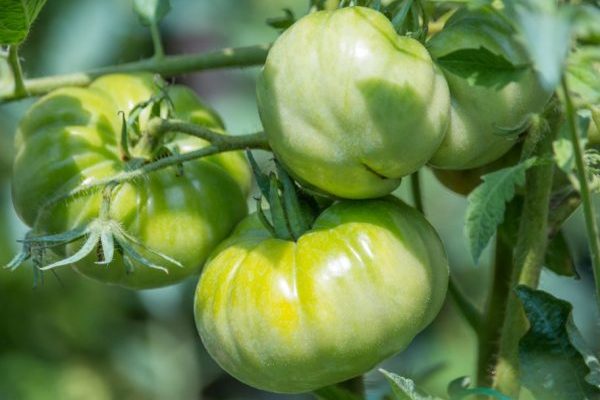

This variety can be grown by germinating seedlings from seeds. In northern regions, seeds should not be planted right away. They must first be sown in a container and left in the germination room. This procedure is performed in early spring. It is better to buy soil in the store, you can also add some fertilizer there to enhance growth. After the seeds hatch, the seedlings need to be placed in a bright place and continue to grow at room temperature.


The soil in the garden must first be dug up, fertilized there, loosened and watered. Since the bushes usually grow too long, you must immediately tie them up with ropes. Otherwise, branches and shoots may break under the weight of the tomatoes.
A gap should also be left between the plants when planting, so it will be more convenient to move there, and more light and nutrition will get to the bushes.
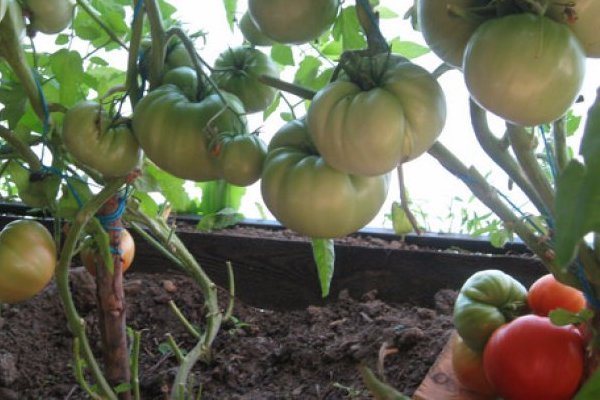

If the soil is rich and high-quality watering is provided, and the care is careful, then the variety will delight you with ripe tasty tomatoes in August.
Since the Babushkino variety belongs to tomatoes, they like regular watering and good soil. If all of this is ensured, you can increase the yield and taste of tomatoes. After all, the taste of tomatoes directly depends on human concern.
Care requirements:
- Tomatoes should be watered regularly, use settled water, and the ridges should not be heavily flooded;
- It is necessary to constantly loosen the soil, so the roots of the plants will receive more nutrition;
- Fertilizers are applied before planting in the ridges, during flowering and fruiting. For this, it is imperative to use peat, manure, mineral fertilizers and organic matter;
- To protect plants from parasites, the bushes should be treated for prophylaxis with special compounds;
- For a bountiful harvest, pinching should be carried out as often as possible. Also, remove excess leaves so that it does not cover the fruits from sunlight and does not interfere with fruiting;
- It is necessary to regularly weed weeds, as their appearance negatively affects the tomato bushes;
- Greenhouses should be ventilated so that moisture does not stagnate there, this will also harden the plants;
- The bushes are still tied up when they are young so that they do not bend or break, they also fix the shoots;
- Tomatoes love fertilized soil. Therefore, due to a lack of potassium, phosphorus or magnesium, they will begin to hurt, become stained, wither and rot.
Read also: How to properly grow bagged strawberries? video
How are tomatoes grown?
Since ripening occurs late, the seeds are planted in mid-February. Planting depth is 2 cm, and the distance between rows is 2-3 cm. After planting, the soil is slightly moistened with a spray bottle and covered with plastic wrap to retain moisture and heat. After the emergence of seedlings, the film is removed, and the container is placed in a bright and warm place.
To protect Grandma's gift from various diseases, the seeds and soil are recommended to be disinfected with a light solution of potassium permanganate.
Grandmother gave a delicious tomato - tomato "Grandma's gift"
Almost half of the winter has passed. Gardeners are thinking about what crops and varieties they will grow on their plots in the next season. Spring is just around the corner. Everyone wants to plant and grow something very outstanding and to their liking. So gardeners are studying descriptions of different varieties of tomatoes before buying the necessary seeds. One of these varieties is the "Babushkin Gift" tomato.


Diseases
Like many varieties of tomatoes, Grandma's gift is prone to phytophthora. This is one of the most dangerous diseases for the nightshade family, to which the tomato belongs.The cause of its occurrence is the spores that can be found on the planting material or in the ground. In conditions of high humidity, spores germinate and provoke a black rot lesion on the stems, leaves and fruits of the tomato.
Prevention
Such a dangerous disease as late blight cannot be treated, and diseased plants are completely removed from the garden and burned away from the garden. Like any other disease, it is easier to prevent than to eradicate.
You can prevent late blight with the help of:
- removing stepchildren;
- increasing the distance between plants;
- moderate watering;
- timely removal of diseased specimens.
Fruits affected by late blight are not suitable for food. Also, it is not fed to pets and birds.
Testimonials
Galina, Tver region
I planted my grandmother's gift for the first time. They write that you need to pinch the top, but I did not. The tomatoes ripened well and for a long time, since the autumn was warm. I tried salting in halves when the fruits were brown and not yet soft. The result was pleasing - the tomatoes did not fall apart, the taste is excellent. I pickled several cans, dividing the tomato into two parts, and very large ones into four, adding mustard powder to the can. So the large size of the tomatoes was not a hindrance. The juice turned out to be tasty, not sour. I used it to cook tomatoes in my own juice - I took a different variety.
Valentina, Kurgan region
In our climate, I grow the tomato grandmother's gift in a greenhouse. I plant tomatoes in two rows in a checkerboard pattern - in the first row I plant early tomatoes with a low bush, in the second - tall and late-ripening ones. It is convenient to handle and harvest with such a planting. I like the taste very much: not bland, but pleasant sweet and sour. Large fruits are convenient to use - one tomato is enough for a salad.

